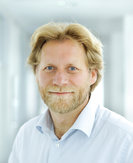InterOFFIS Intelligent Ambient Living and Working in the Ageing Society
Motivation
OFFIS currently focuses its research activities in six research and development divisions, each of which operates in a unique scientific community with their respective specific competencies. In the context of an internal process, OFFIS moves toward providing itself with a unified vision that allows for synergies between the different R&D divisions, and, in this way, contributing to the innovative force of the institute by focusing its profile. This vision bears the title Intelligent Ambient Living and Working in the Ageing Society.
Predictions and studies on the changes in the world during the coming 10-20 years are basic to these considerations. On the one hand, the expected technical advancements play a role (Moore`s Law: doubling of transistor density on integrated circuits every 18 months). More important, however, are the expected social changes (keyword "ageing society"). Thus, in our view, sustainable building has many technological and social facets, next to the more commonly mentioned architectural and infrastructural aspects. Being an IT research and development institute, the central interest of OFFIS lies in the IT aspects. Nevertheless, we think that in this respect the user with his needs should be clearly emphasized. An important point in this context is the following quote from a recent judgement of the German Federal Court of Justice: "In the protection from falling and injury of the elderly in nursing homes, their dignity and autonomy must be preserved". One particular way of protecting and preserving the dignity of elderly people would be to enable them to reach old age while continuing to experience independent quality of life, to a certain degree, in their familiar living environment (at home), while at the same time having care facilities in hospital or nursing home quality at their disposal. This challenge is to be met with intelligent technologies (keyword: ambient assisted living).
Goal
In our opinion, existing solutions for 'health care' and 'intelligent' housing are flawed in the sense that they were not designed with holistic integration in mind. Instead, they are usually implemented by technicians and engineers and often fail to solve the problems of the target group. This leads to diminished acceptance, increased acceptance barriers, or even no acceptance at all.
Thus, it is a goal of InterOFFIS to create an integrated solution for the ageing society. Not technology should be emphasized, but the person interfacing with technology in his environment.
For this reason, a room is furnished with home automation that meets the specific needs of the elderly. The biggest challenge in the implementation of the room consisted of combining all the different communication systems that are used by appliances produced by different manufacturers. Since there is no universal communication standard for home automation systems yet, the various communication systems have to be combined into an integrated system and be made available through a common interface.
Contribution of the HS Division
The OFFIS Design-Center of the HS Division brings its experiences and competences in the areas Open Services Gateway Initiative (OSGi), network technologies (UPnP – Universal Plug and Play, EIB – European Installation Bus, and LON – Local Operating Network), and design methodology for embedded systems into the project. These competences are combined and integrated into a Multi Service Home Platform (MSHP), which forms the platform for the unification of communication protocols and transparently integrates all devices and appliances independently from the various underlying network technologies. In this way, with the help of the MSHP, firstly the internal communication over EIB, LON, or Ethernet, for example, is realized while the user is provided with a unified view of the end devices through the hardware abstraction layer. Secondly, the MSHP offers interfaces to the outside world; in the context of the InterOFFIS application for example to the physician`s or the pharmacist`s.
Internal Leader
Scientific Director
Duration
End: 30.12.2008


